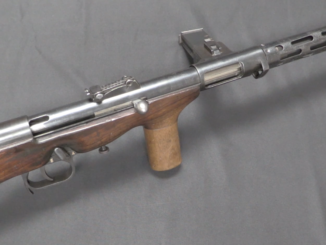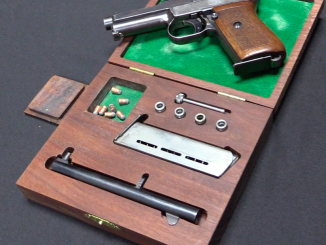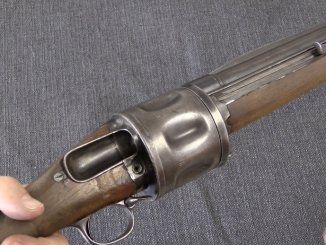When the G11 program was cancelled and German reunified, the West German military was still using the 7.62mm G3 rifle, while the East German forces had AK-74 variants. Neither of these were suitable for a new unified German NATO-member Bundeswehr – a rifle in 5.56mm NATO was needed. Heckler & Koch had been working on just such a weapon, designated internally as the HK50.
The rifle is fundamentally an AR-18 derivative, with a multi-lug rotating bolt and a short stroke gas system of the G43 and SVT type. It is made with extensive use of polymer parts, and it extremely easy to strip. It is fitted for an integral optical sight, on the Bundeswehr model a combination laser, fiber-optic red dot, and magnified scope. The weapon was adopted as the G36 by the German military, and was also adopted by Spain to replace the CETME-L. A multitude of smaller police and security agencies have also adopted it, including the US Capitol Police.
Thanks to H&K USA for generously granting me access to bring there to you!




This was a ‘missing link’ in so far demonstrated HK development line. Ian has done a masterful job in presenting it with healthy doze of diplomacy on top.
In my way of seeing it, there is little to fault HK for in this design. Everything seem to be right and teutonically thorough. Sight combo is impressive, although bit over the top. Of course anyone who comes later can improve on certain important points. Such was the case with designing Tavor where sight base is metal and connected solid with the barrel.
“missing”
Here, we can’t forget about G41: https://modernfirearms.net/en/assault-rifles/germany-assault-rifles/hk-g41-eng/
which was derivative of G3 firing 5,56×45 NATO, but which found no customers, being too expensive.
“NATO-member Bundeswehr”
Wait, Modern Firearms says that G41 used STANAG compatible magazines and G36 proprietary 30-rounds box magazines. Does this mean G36 do NOT accept STANAG magazines? If yes what was reason of such choice i.e. using own unique magazines? Did anybody offered rework or adaptor for STANAG magazines?
Yes, you are right. I went a bit on ‘tangent’ as they say here 🙂
As I recall and if my memory serves me well, I heard that the preceding model, the HK33 was not very strong in reliability department. May it be that 5.56mm shot is not suitable for HK type of retarded blowback? Too whippy and not enough steam behind it, perhaps.
If that lead HK do depart from roller-lock and go into “true and tried” gas operation, it only makes sense.
“Too whippy and not enough steam”
What about CETME Ameli:
https://modernfirearms.net/en/machineguns/spain-machineguns/cetme-ameli-eng/
?
I would like answer to it too. I remember saying: “if two are doing the ‘same’, it does not mean it actually IS the same”.
In addition, on Ameli there is a bit more mass to push around. And the belt. Let’s phone them up 🙂
“In addition, on Ameli there is a bit more mass to push around. And the belt. Let’s phone them up”
The fact it has belt-fed suggest that 5,56×45 NATO “has enough steam”. There also existed HK23E machine gun. HK33 also seems to be commercially successful:
https://modernfirearms.net/en/assault-rifles/germany-assault-rifles/hk-hk33-i-hk53-eng/
And I would rather except more problems with up-scaling design that down-scaling it.
Also basic roller-delayed blow-back system was also up-scaled by H&K to 12,7×99 NATO cartridge, giving in effect HK 25 machine gun. It never went into production so it is hard to say how well it would work in reality, nonetheless IIRC H&K offered it in their catalogs, so I presume by that moment it must was debugged enough to work satisfactorily.
The magazines…. yes they are odd ones. But, they are 10x stronger and better in every respect than “dog-legged” M16 GI style one.
Interestingly, CZUB have used as an option the same “odd” German magazine for their 805 model rifle. They probably knew why.
“They probably knew why.”
Because customer wanted so?
International missions, that is the answer.
As Ian said in the video, HK offers an M16 (stanag) mag well.
“Magazine well” is spot on
Interchangeable mag Wells bride the unbridgeable gap between a reliable but not dog leg POS mag
And the bureaucrapic id[iocy]eal of everyone using that dogleg POS.
It does look good!
And yeah, if forces want an MG, then the people who carry it have to put up with the additional weight of carrying heavier built guns to accept the heat loading.
I’m going to have to have another watch through to see how the trunion is attached and how the bolt is indexed during the feed part of the cycle
I guess that the AR18 opened the way to plastic fantastic construction by running the bolt carrier on guide rods.
I’m also going to have to take another look to see whether the gas piston uses Sullivan’s AR18 ball joint to allow the piston to align itself within the gas cylinder.
Regarding East German legacy rifles, there is something to ponder. From this information you can see that there was/ is still space for development HK could have built on.
https://www.thefirearmblog.com/blog/2018/12/27/saiga-mk-svarog-first-project-of-kalashnikov-concerns-custom-shop/
In general sense, we can see that rifles of “allies” or “opponents” increasingly begin to resemble each other. Is this sign of ideological/ technical meekness? I do not think so.
Well, arms makers are not prohibited from studying weapons of neighbors or adversaries. No good weapon system is ever developed in complete isolation from the real world! I need not mention why the M14 would lose to the MAS-49/56 in muddy jungle fights where everyone gets dunked in the mud before shooting starts… or am I wrong?
Precisely so; you have good grasp of it.
“meekness”
Would I negate this if I point that Lobaev is planning development of new fast cartridge (muzzle velocity around 2000 m/s)?
https://www.thefirearmblog.com/blog/2018/09/28/russian-lobaev-arms-to-develop-hypersonic-ammunition/
I know Russkies are working on new and radical stuff, just as they displayed with launch of hypersonic missile recently (M20 woo-hoo!). No meekness there ,one bit.
More like “convergent evolution.” Once someone comes up with the optimal way of doing something, everyone else starts doing it the same way.
Btw, check out this 5.56mm mag, it is not even remotely similar to HK one.
This isn’t uncommon for Soviet-provenance weapons for 5,56×45 cartridge, see for example:
STG 940 https://modernfirearms.net/en/assault-rifles/wieger-stg-940-2/
BERYL https://modernfirearms.net/en/assault-rifles/poland-assault-rifles/wz-96-beryl-eng/
Something on side (when we have this end of year); ignore IF you wish:
https://www.youtube.com/watch?v=sV8wH9mfLGI
I just love Ronnie.
There is no STANAG for 5.56 mm magazines. There was a proposal that failed to be accepted.
You must be correct. They talk about “NATO standard magazine” here which may not be same as Stanag 4179
https://www.czub.cz/media/military.pdf
what implies from this is that it remained a “proposal”
https://en.wikipedia.org/wiki/STANAG_magazine
I was under impression it WAS a standard.
So it seems it is not formally standard, but is de facto standard by its wide usage.
Out of the five ‘NATO Nominated Weapons’ currently in service with NATO member nations, 4 of these accept the 30-round AR-15 magazine described in Draft STANAG 4179 (they are FN FNC, AR70/90, L85A2, and M16A2). The fifth is G36.
I think it showed integrity by Ian to mention the recent issues around the G36 at all, given that he was enjoying H&K’s hospitality. It was also good of H&K to not make his visit conditional upon the matter not being mentioned in the video.
Good point; he is doing good job on many levels.
… another way how to skin cat
https://www.youtube.com/watch?v=VifJZEbbMoc
Yeah, the metal is real!
Mexico was one time considering purchase of license for G36. Then they decided to build their own…. and result is pretty close
https://www.youtube.com/watch?v=26xlZHF-R5w
– but not the same.
Actually, there was debate if they copied G36 and almost ended up with litigation. But, eventually HK drop the charges.
According to https://modernfirearms.net/en/assault-rifles/mexico-assault-rifles/fx-05-xiuhcoatl-eng/
FX-05 does not have any of the patented features of the G36, and have enough internal differences to be considered an original design, although its design is obviously heavily influenced by the German rifle.
I first saw these in Miami. Then in Spain.
The optic will probably be included in any successor German service rifle, yes?
Imagine the Wieger/Wiesa-Germany with M16 magazines built in Wiesa with the crazy optics and trimmings installed by H und K?
I’m not sure the G41 would have been more expensive than the G36 to build? Then again… It may well prove that H und K actually built some of these with crummy-but-cheaper-polymer-plastics, and so why the basic design may be OK, even in hot countries, but the rifle is due to be replaced. Meanwhile the Baltic States, or at least Lithuania, are satisfied with the things…
Here’s a thought: If in Nato, adopt the C-8 Canadian rifle that uses M16 mags? Just a thought. Danes, Dutch, Canadians and British SAS seem happy enough with ’em.
I guess that with the fall of the DDR, the entrenched political and military sponsors of the DDR arms makers disappeared as well
Adoption of the ak74 bayonet certain saved some money
The investment cast bayonet for the SA80 with its hand chilling and hand burning cylindrical steel handle (and you can’t tell what the orientation of the blade is by feel)…
Allegedly cost £8m to develop in 1984 £
Say about £30m in today’s £/$/€/one world fiat currency
As Hand Gunner magazine noted at the time
It’s a good job that those graduates were not given the job of inventing the wheel barrow!
The 7.62x39mm MPi72s mit KMS folding butt, etc. were sold to Finland… Poland got some of the MiG29s. I was in Hamburg when some “tractors” under tarps headed for Israel proved to be quad ZSU23s upon closer inspection… Quite the “fire sale!” DDR stahlhelm/ helmets went to Turkey and all sorts of places.
The Bundeswehr retained the AK74 bayonet / wire cutter (so clever!) and Berlin kept the cross-walk “safe to cross” walking man signals with his charming Homburg hat.
No idea what became of all the 5.45mm and 9x18mm weapons, although I suspect the latter are still in Polizei barracks even if the fiat currency EU mandated blue uniforms instead of the rather more traditional green and brown Polizei uniforms.
The G36, as many other modern assault rifles, was clearly inspired by the Armalite AR18, but H&K engineers improved the AR18 gas system (derived from the Tokarev design). They reversed the gas cylinder and piston. In the AR18 the piston is fixed, and the cylinder is a cup attached to the operating rod (and then a moving part) whereas in the G36 rifle the gas cylinder is fixed to the barrel, in a conventional form.
And what about an even more rare and scarce German designed assault rifle such as the Wieger STG-940 family of assault rifles?They were designed not only as a eventual replacement of the license-made MPI-AK-74 in the former GDR, but also intended as an export weapon. The Peruvian and Indian armies ordered those rifles but all those plans were curtailed by the Fall of Berlin Wall and later on by the German Reunification on October 3rd, 1990. So, there were a very few examples of a pre-production batch.